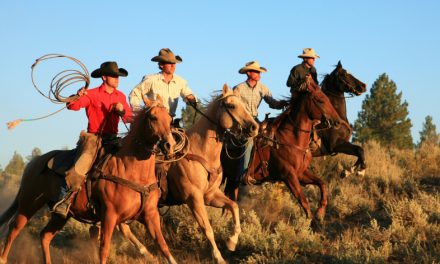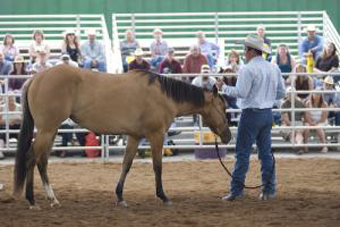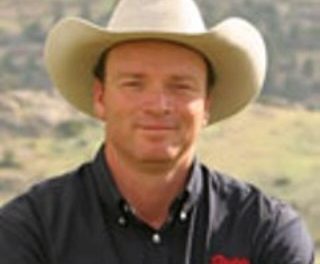 Flying lead changes… just the mention will chill the blood of many experienced riders. This month, we are going to break down the fundamentals of flying lead changes and simplify them. With the right foundation in place, they are not that hard! To get a good flying lead change, you need two basic elements: first, you need to have control of your horse’s hindquarters. Second, you need to be able to maintain control of your own body when you are riding, keeping yourself centered and balanced on your horse at all times.
Flying lead changes… just the mention will chill the blood of many experienced riders. This month, we are going to break down the fundamentals of flying lead changes and simplify them. With the right foundation in place, they are not that hard! To get a good flying lead change, you need two basic elements: first, you need to have control of your horse’s hindquarters. Second, you need to be able to maintain control of your own body when you are riding, keeping yourself centered and balanced on your horse at all times.
Since flying lead changes are an advanced maneuver, this article assumes that you have knowledge of some riding terms and exercises, and assumes that your horse is broke and that he already knows how to move off your leg and rein pressure.
To start, practice the turn on the forehand. Your horse should soften in the bridle and move his hindquarters over off pressure from your leg. Then, you will walk your horse forward, pick up and soften his face, move his hindquarters over, and move back out at a walk immediately. Practice this at both the walk and trot (trotting in, moving the hindquarters over, and trotting out). Once this is going well, the next step is to teach your horse to move his hip in as you travel on a straight line.
Move to the fence to start this exercise. Walk down the rail, and tip your horse’s nose slightly to the inside. Instead of turning in, though, ask him to step his hip over while keeping his shoulders straight using your outside leg. Your horse won’t know what you want at first. To explain, pick up and ask for his hips to move in with your outside leg, and if he does not, tip his nose to the outside of the arena, move his hips over (to the inside) a step, and then straighten his nose and walk out of it. You need to practice this part of the exercise until you can get your horse to step his hips in on cue with just a little pressure from your outside leg. Once you can get this at the walk very consistently, free up the front end a little and start moving out into the arena in a half-pass. Make sure your horse is always leading with the hip in the half-pass. Use your reins to keep the shoulders under control so the hips are always leading. When you are doing this, your body will be sitting slightly to the outside. It’s easy to lean in during this part of the exercise, but that just makes it harder for your horse as your body weight gets in his way.
Once you are getting your horse to move his hips in very well on the fence, move into the center of the arena and start practicing it down the center line. Walk forward, have your horse step his hips to one side, and then smoothly change the bend of his nose and change which leg you are cuing with, and have him step his hip to the other side. You are now doing all the movements for a flying lead change at the walk. It’s also helpful to practice your side pass like this, switching from one direction to the other smoothly and quietly. These transitions help your horse get the muscle memory for the movements you will be asking for when you speed up and do the flying lead changes. Practice these exercises at the walk and trot until they are solid at both gaits.
Next, teach your horse to do a reverse arc circle. First you need to be able to walk a nice, round, consistent circle. Make sure you get this part before moving on to the rest of the exercise. If your horse is falling in or drifting out, use your legs to correct him. Once you have your consistent circle, tip your horse’s nose a little to the outside of the circle, but keep your body riding on the same bend of the circle you have been making. When you get a few steps where your horse is walking the circle correctly with his nose tipped out, turn him so he is following his nose back on the circle, and release him. It is important that you have your horse follow his nose at the walk and trot to end this exercise, so he doesn’t start running away through his shoulders. Keep building to get more and more steps in a row until you can get an entire circle with your horse’s nose tipped out. Once this is solid at the walk and trot, practice it at the lope. The only thing that changes is you don’t need to have your horse follow his nose again at the end of each lope exercise. He knows to do that from the practicing you did at the walk and trot and you don’t need to practice it more when you are loping. Remember to look where you want to go when you are practicing this exercise, and be sure to do this in both directions. The more you lope reverse arc circles in preparation for your flying lead changes, the better. You can’t practice this part too much! Make sure your horse’s nose stays soft through this exercise.
Next, go back and practice the hips in exercise at a lope. Lope a straight line, move the hips in, and soften your horse’s nose. Practice this until you can almost lope sideways across the arena. Make sure not to race through these exercises. Keep things calm, precise, and keep your horse soft in the bridle throughout.
Now, for the flying lead changes. Start by picking up the correct lead, and then lope a reverse arc circle. When you are ready to change leads, tip your horse’s nose to the outside and switch which leg you are cuing with to push the hip over for the new lead. Your horse should pick up the new lead. Remember, this doesn’t have to be perfect at first, but your fundamentals to need to be solid. Just try to make the exercises quieter and softer as you go. Practice each of the pieces of this exercise, put them together, and your flying lead changes will happen.
Enjoy your horses and until next time, may God bless the trails you ride.
For more information on Ken McNabb’s programs call us at 307-645-3149 or go to www.kenmcnabb.com




